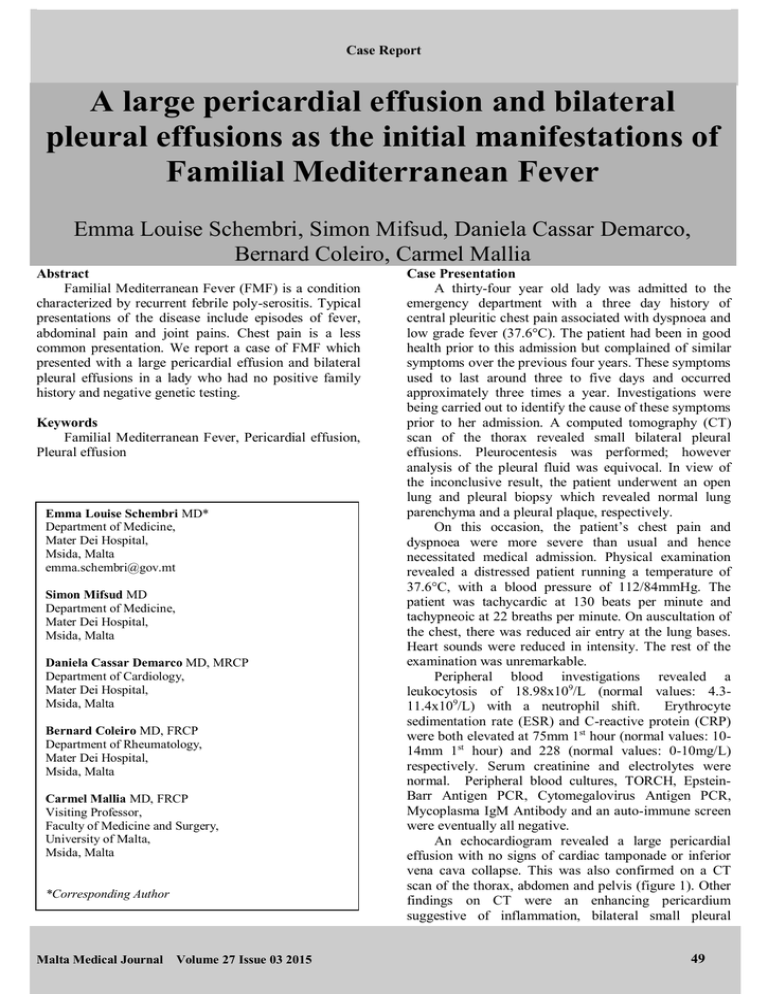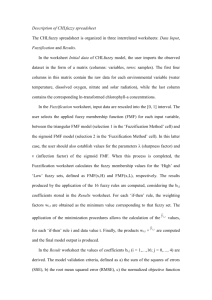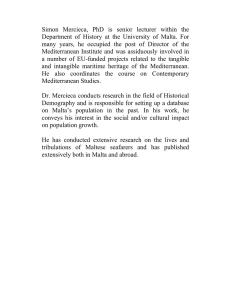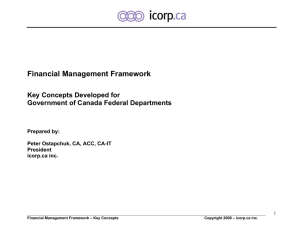Document 13553344
advertisement

Case Report A large pericardial effusion and bilateral pleural effusions as the initial manifestations of Familial Mediterranean Fever Emma Louise Schembri, Simon Mifsud, Daniela Cassar Demarco, Bernard Coleiro, Carmel Mallia Abstract Familial Mediterranean Fever (FMF) is a condition characterized by recurrent febrile poly-serositis. Typical presentations of the disease include episodes of fever, abdominal pain and joint pains. Chest pain is a less common presentation. We report a case of FMF which presented with a large pericardial effusion and bilateral pleural effusions in a lady who had no positive family history and negative genetic testing. Keywords Familial Mediterranean Fever, Pericardial effusion, Pleural effusion Emma Louise Schembri MD* Department of Medicine, Mater Dei Hospital, Msida, Malta emma.schembri@gov.mt Simon Mifsud MD Department of Medicine, Mater Dei Hospital, Msida, Malta Daniela Cassar Demarco MD, MRCP Department of Cardiology, Mater Dei Hospital, Msida, Malta Bernard Coleiro MD, FRCP Department of Rheumatology, Mater Dei Hospital, Msida, Malta Carmel Mallia MD, FRCP Visiting Professor, Faculty of Medicine and Surgery, University of Malta, Msida, Malta *Corresponding Author Malta Medical Journal Volume 27 Issue 03 2015 Case Presentation A thirty-four year old lady was admitted to the emergency department with a three day history of central pleuritic chest pain associated with dyspnoea and low grade fever (37.6°C). The patient had been in good health prior to this admission but complained of similar symptoms over the previous four years. These symptoms used to last around three to five days and occurred approximately three times a year. Investigations were being carried out to identify the cause of these symptoms prior to her admission. A computed tomography (CT) scan of the thorax revealed small bilateral pleural effusions. Pleurocentesis was performed; however analysis of the pleural fluid was equivocal. In view of the inconclusive result, the patient underwent an open lung and pleural biopsy which revealed normal lung parenchyma and a pleural plaque, respectively. On this occasion, the patient’s chest pain and dyspnoea were more severe than usual and hence necessitated medical admission. Physical examination revealed a distressed patient running a temperature of 37.6°C, with a blood pressure of 112/84mmHg. The patient was tachycardic at 130 beats per minute and tachypneoic at 22 breaths per minute. On auscultation of the chest, there was reduced air entry at the lung bases. Heart sounds were reduced in intensity. The rest of the examination was unremarkable. Peripheral blood investigations revealed a leukocytosis of 18.98x109/L (normal values: 4.311.4x109/L) with a neutrophil shift. Erythrocyte sedimentation rate (ESR) and C-reactive protein (CRP) were both elevated at 75mm 1st hour (normal values: 1014mm 1st hour) and 228 (normal values: 0-10mg/L) respectively. Serum creatinine and electrolytes were normal. Peripheral blood cultures, TORCH, EpsteinBarr Antigen PCR, Cytomegalovirus Antigen PCR, Mycoplasma IgM Antibody and an auto-immune screen were eventually all negative. An echocardiogram revealed a large pericardial effusion with no signs of cardiac tamponade or inferior vena cava collapse. This was also confirmed on a CT scan of the thorax, abdomen and pelvis (figure 1). Other findings on CT were an enhancing pericardium suggestive of inflammation, bilateral small pleural 49 Case Report effusions and minimal ascites. These findings were in keeping with the presence of poly-serositis. Figure 1: CT thorax showing the large pericardial effusion and small bilateral pleural effusions. Pending blood culture and auto-immune screen results, empirical treatment with intra-venous piperacillin-tazobactam was commenced. This antibiotic therapy failed to improve the patient’s symptoms and the inflammatory markers remained elevated. In view of these intermittent, recurrent, self-resolving episodes of febrile pleuritis and pericarditis, a working diagnosis of Familial Mediterranean Fever (FMF) was put forward. Genetic testing for the condition was done. The antibiotics were stopped and colchicine was prescribed at 1mg daily. There was an immediate good response to colchicine therapy, and this continued to favour a diagnosis of FMF. In view of the large pericardial effusion, the patient was given a single intravenous dose of methylprednisolone to hasten its resolution. Daily echocardiograms showed a reduction in the pericardial effusion to a size of 8mm following the initiation of colchicine therapy. The patient was completely asymptomatic after seven days when she was discharged on colchicine 1mg daily. A follow up echocardiogram two weeks after discharge confirmed that the pericardial effusion did not re-accumulate. The patient will have regular follow up outpatient appointments. Discussion Familial Mediterranean Fever (FMF) is a recurrent febrile poly-serositis inherited in an autosomal recessive manner, affecting mostly individuals of Mediterranean descent. FMF is characterized by brief recurrent, selflimiting episodes of fever, peritonitis, pleuritis, arthritis and myalgia. The most frequent presenting manifestations include abdominal pain (90%), articular involvement (75%) and chest pain due to pleuritis or pericarditis (30-40%).1 Pericardial involvement rates in FMF are variable with different studies giving incidence rates of 0.7%, 2 1.4%,3 and 27%.4 These studies have all concluded that Malta Medical Journal Volume 27 Issue 03 2015 pericardial involvement is a manifestation of FMF. The low incidence rates may be due to under-diagnosis whereas the higher rates can be due to the various methods used to define and detect pericarditis and pericardial effusion;5-6 hence explaining the substantial variability in incidence. This case describes a large pericardial effusion and bilateral pleural effusions as the major presenting features of FMF without any joint or abdominal involvement. This case is also quite unusual since the condition typically presents in childhood and rarely occurs after the age of thirty.7 In this case, the lack of a positive family history for FMF made the diagnosis of FMF more challenging. However, the word ‘familial’ in FMF is a misnomer since only 50% of patients with FMF have a positive family history.7-9 Thus; a negative family history does not exclude a diagnosis of FMF. This case highlights the fact that FMF requires a high index of clinical suspicion as early recognition may be clinically difficult in view of its non-specific presentation. In order to help clinicians in differentiating FMF from other periodic febrile illnesses, the TelHashomer Revisited Criteria can be used for the diagnosis of FMF. These criteria are divided into three major and three minor criteria as demonstrated in table 1. A ‘definitive’ diagnosis of FMF requires the presence of two major criteria or one major and two minor criteria. The diagnosis is considered as ‘probable’ if only one major and one minor criteria are present. Table 1: Tel-Hashomer Revisited Criteria for the diagnosis of FMF Tel-Hashomer Revisited Criteria for the diagnosis of FMF10 Major Criteria Recurrent febrile episodes with serositis or synovitis Amyloid A amyloidosis without a predisposing cause Response to continuous colchicine prophylaxis Minor Criteria Recurrent febrile episodes Erysipelas-like erythema FMF in a 1st degree relative Patient’s Case: Present or Absent Present Absent Present Patient’s Case: Present or Absent Present Absent Absent From the results shown in table 1, this patient had satisfied two major and one minor criteria suggesting a ‘definitive’ diagnosis of FMF. The Tel-Hashomer 50 Case Report Revisited Criteria can be used as a diagnostic adjunct given the difficulty of diagnosing FMF. A study by Livneh A. et al, concluded that the new set of TelHashomer Criteria were highly sensitive (>95%) and specific (>97%) and were reliable in diagnosing and distinguishing FMF from other periodic illnesses. 11 The gene responsible for FMF is the MEditerranean FeVer gene (MEFV) located on chromosome 16. The most common mutations are found in exon 2 and 10 of the gene. This patient had no mutations identified in exon 2 and 10 of the MEFV gene. Despite the negative genetic test, one must note that genetic testing only has a 70-80% positive predictive value and the diagnosis of FMF remains clinical.1, 12 This is of marked importance in the Maltese isles, as no data exists regarding the frequency of the various mutations involved in FMF. This means that FMF is a clinical diagnosis and genetic testing may help confirm the diagnosis but not exclude it. Hence, in such situations the Tel-Hashomer Revisited Criteria are extremely valuable. Making an early diagnosis of FMF is of utmost benefit to the patient for two main reasons: 1. The avoidance of many unnecessary investigations and possible surgical interventions.1 2. Early treatment with colchicine. Colchicine is a tricyclic alkaloid that diminishes the number of FMF attacks,10 and hence prevents the occurrence of Amyloid A amyloidosis and eventually renal failure.1, 13-14 Assessment of renal amyloidosis is done via regular urinalysis to check for proteinuria. If proteinuria is detected, more definitive renal studies are required to assess the degree of renal amyloid deposition.15 Colchicine is the mainstay of treatment in FMF.13 However in colchicine resistant cases of FMF other agents have been put forward including corticosteroids, non-biological and biological DMARDs, interferonalpha16, anti-TNF agents17 and interleukin-1 receptor antagonists18-20. These immunosuppressive agents may be beneficial in an acute inflammatory episode of FMF but their role in FMF prophylaxis and prevention of amyloidosis is unclear.17 Despite the treatment currently available for FMF some patients still have regular flare-ups. This emphasizes the importance of continuous research for further effective FMF treatment. There is ongoing research focussing on colchicine analogues which have a greater therapeutic window and are less toxic than colchicine.21 In conclusion, pericardial involvement is a rare but well known manifestation of FMF. Pericardial effusions in FMF usually regress with no permanent defect. Nonetheless, a study by Dabestani et al, demonstrated that there have been cases of pericardial tamponade and constrictive pericarditis secondary to FMF, as well as a higher risk of progression of FMF and amyloidosis in Malta Medical Journal Volume 27 Issue 03 2015 patients with pericardial involvement.4, 6 This highlights the importance of evaluating patients with FMF carefully and assessing for pericardial involvement. Long term follow up of such cases by both rheumatologists and cardiologists may help prevent the occurrence of complications. Acknowledgements We would like to thank the patient for allowing us to publish her case, and Mr. Alexander Manché (Consultant Cardio-Thoracic Surgeon; Department of Cardiac Services, Mater Dei Hospital, Malta) who performed the open lung and pleural biopsy. References 1. 2. 3. 4. 5. 6. 7. 8. 9. 10. 11. 12. 13. 14. 15. Soriano A, Manna R. Familial Mediterranean fever: new phenotypes. Autoimmun Rev. 2012; 12(1): 31-7. Kees S, Langevitz P, Zemer D, Padeh S, Pras M, Livneh A. Attacks of pericarditis as a manifestation of familial Mediterranean fever (FMF). QJ Med 1997; 90: 643-647. Tunca M, Akar S, Onen F, Ozdogan H, Kasapcopur O, Yalcinkaya F, et al. Familial Mediterranean fever (FMF) in Turkey: results of a nationwide multicentre study. Medicine (Baltimore). 2005; 84(1): 1-11. Dabestani A, Noble LM, Child JS, Krivokapich J, Schwabe AD. Pericardial disease in familial Mediterranean fever: an echocardiographic study. Chest. 1982; 81(5): 592-5. Tutar E, Yalçinkaya F, Özkaya N, Ekim M, Atalay S. Incidence of pericardial effusion during attacks of familial Mediterranean fever. Heart. 2003; 89(10): 1257–1258. Okutur K, Seber S, Oztekin E, Bes C, Borlu F. Recurrent pericarditis as the initial manifestation of Familial Mediterranean fever. Med SciMonit, 2008; 14(12): CS139-141. Ahmadinejad Z, Mansori S, Ziaee V, Alijani N, Aghighi Y, Parvaneh N, et al. Periodic Fever: A Review on Clinical, Management and Guideline for Iranian Patients - Part I. Iran J Pediatr 2014; 24(1): 1-13. Stone, John H. (Ed.). A Clinician's Pearls & Myths in Rheumatology. London: Springer; 2009. Vogel Y, Buchner NJ, Haverkamp T, Henning BF. Familial Mediterranean fever. Rare manifestation without fever and with inconspicuous family case history. Dtsch Med Wochenschr. 2008; 133(31-32): 1621-4. Katsenos S, Mermigkis C, Psathakis K, Tsintiris K, Polychronopoulos V, Panagou P, et al. Unilateral lymphocytic pleuritis as a manifestation of familial Mediterranean fever. Chest. 2008 Apr; 133(4): 999-1001. Livneh A, Langevitz P, Zemer D, Zaks N, Kees S, Lidar T, et al. Criteria for the diagnosis of familial mediterranean fever. Arthritis & Rheumatism. 1997; 40: 1879–1885. Samuels J, Aksentijevich I, TorosyanY,Centola M, Deng Z, Sood R, et al. Familial Mediterranean fever at the millennium. Clinical spectrum, ancient mutations, and a survey of 100 American referrals to the National Institutes of Health. Medicine (Baltimore). 1998; 77(4): 268-97. Medlej-Hashim M, Loiselet J, Lefranc G, Megarbane A. Familial Mediterranean Fever (FMF): from diagnosis to treatment. Sante. 2004; 14(4): 261-6. Onen F. Familial Mediterranean fever. Rheumatology International. 2006; 26(6): 489-496. Zadeh N, Getzug T, Grody W. Diagnosis and management of familial Mediterranean fever: Integrating medical genetics in a dedicated interdisciplinary clinic. Genetics in Medicine. 2011; 13: 263–269. 51 Case Report 16. Ozturk MA, Kanbay M, Kasapoglu B, Onat A, Guz G, Furst D, et al. Therapeutic approach to familial Mediterranean fever: a review update.ClinExpRheumatol. 2011; 29(4): 77-86. 17. Amital H, Ben-Chetrit E. Therapeutic approaches to familial Mediterranean fever. What do we know and where are we going to? ClinExpRheumatol. 2004; 22 (Suppl. 34): S4-S7. 18. Calligaris L, Marchetti F, Tommasini A, Ventura A. The efficacy of anakinra in an adolescent with colchicine-resistant familial Mediterranean fever. European Journal of Pediatrics. 2008; 167(6): 695–696. 19. Kuijk LM, Govers AMAP, Hofhuis WJD, Frenkel J. Effective treatment of a colchicine‐resistant familial Mediterranean fever patient with anakinra. Ann Rheum Dis. 2007; 66(11): 1545– 1546. 20. Moser C, Pohl G, Haslinger I, Knapp S, Rowczenio D, Russel T, et al. Successful treatment of familial Mediterranean fever with Anakinra and outcome after renal transplantation. Nephrol Dial Transplant. 2009; 24(2): 676-8. 21. Cerquaglia C, Diaco M, Nucera G, La Regina M, Montalto M, Manna R. Pharmacological and clinical basis of treatment of Familial Mediterranean Fever (FMF) with colchicine or analogues: an update. Curr Drug Targets Inflamm Allergy. 2005; 4(1): 117-24. Corinthia Group Prize in Paediatrics, 2015 The Corinthia Group Prize in Paediatrics for 2015 was awarded to Dr Luke Saliba, who obtained the highest aggregate mark over the combined examinations in Paediatrics in the fourth and final year of the undergraduate course. Whilst offering our congratulations to Dr Saliba, we would also like to congratulate all those who performed admirably during the undergraduate course in Paediatrics. In the accompanying photograph, Dr Saliba is seen receiving a cheque for €233 from Professor Simon Attard Montalto, Head of Paediatrics, in the Boardroom of Medical School. Finally, the Academic Department of Paediatrics and Medical School remain indebted and are extremely grateful to the Corinthia Group for their ongoing support. Professor Simon Attard Montalto Malta Medical Journal Volume 27 Issue 03 2015 52




